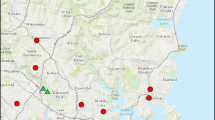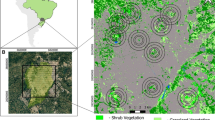Abstract
Bees are important flower-visiting insects that display differential occurrences at food resources throughout urban and wildland landscapes. This study examined the visitation rates and foraging patterns of eight taxonomic groups of bees that are common to California poppies, Eschscholzia californica, in both landscape types. Bee occurrence was documented in relation to floral resource characteristics (patch area, poppy coverage, and poppy density), local landscape characteristics (distance to the wildland-urban interface, distance to riparian areas, distance to green space, and land use), and regional landscape context (urban versus wildland). Similar abundance and richness measures were recorded at both urban and wildland poppy patches, but community composition varied in each landscape. Bumble bees were more abundant at poppies in the wildland whereas species in the family Halictidae (sweat bees) were more abundant at poppies within the urban landscape. Resource patch size and density consistently correlated with increased bee presence for all bee types foraging in the wildland. Individual patterns of occurrence in the urban landscape were somewhat divergent; the foraging dynamics of larger bodied-bees (Bombus vosnesenskii and Megachile species) correlated significantly with resource patch size and density, whereas smaller-bodied bees (family Halictidae and Andrena species) were influenced by landscape characteristics such as distance to the wildland-urban interface and distance to riparian areas. In summary, the surrounding landscape had an influence on community composition, but the magnitude of the floral resource present at a site and factors relating to foraging energetics were dominant drivers of local occurrence. These results suggest that management strategies that provide dense and abundant floral resources should be successful in attracting bees, irrespective of their location within the urban matrix.




Similar content being viewed by others
References
Ahrne K, Bengtsson J, Elmqvist T (2009) Bumble bees (Bombus spp.) along a gradient of increasing urbanization. PLoS 4(5): e5574:1–9
Antonini Y, Costa RG, Martins RP (2006) Floral preferences of a neotropical stingless bee, melipona quadrifasciata lepeletier (apidad: meliponia) in an urban forest fragment. Braz J Biol 66(2A):463–471
Araujo ED, Costa M, Chaud-Netto J, Fowler HG (2004) Body size and flight distance in stingless bees (hymenotpera: meliponini): inference of flight range and possible ecological implications. Braz J Biol 64(3B):563–568
Bierzychudek P (1981) Pollinator limitation of plant reproductive effort. Am Nat 117:838–840
Buchmann SL, Ascher JS (2005) The plight of pollinating bees. Bee World 86:71–74
Cane J, Minckley R, Kervin L, Roulston T, Williams N (2006) Complex responses within a desert bee guild (hymenoptera: apiformes) to urban habitat fragmentation. Ecol Appl 16:632–644
Carre G, Roch P, Chifflet R, Morison N, Bommarco R, Harrison-Cripps J, Krewenka K, Potts S, Roberts SPM, Rodet G, Settele J, Steffan-Dewenter I, Szentgyorgyi H, Tscheulin T, Westphal C, Woyciechowski M, Vaissiere B (2009) Landscape context and habitat type as drivers of bee diversity in European annual crops. Agric Ecosyst Environ 133:40–47
Cartar RV, Real LA (1997) Habitat structure and animal movement: the behaviour of bumble bees in uniform and random spatial resource distributions. Oecologia 112:430–434
City of Berkeley (2009) Planning and development department: land use. [online] URL: http://www.ci.berkeley.ca.us/SubUnitHome.aspx?id=32594
City of Emeryville (2009) General land use map. [online] URL: http://www.ci.emeryville.ca.us/index.aspx?nid=545
City of Oakland (2009) CEDA: Planning and Zoning Department. [online] URL: http://oaklandnet.com/government/ceda/
Collevatti RG, Schoereder JH, Campos LAO (2000) Foraging behavior of bee pollinators on the tropical weed Triumfetta semitriloba: flight distance and directionality. Rev Bras Biol 60:29–37
East Bay Regional Park District (2011) East Bay Regional Parks. [online] URL: http://www.ebparks.org/parks
Fetridge ED, Ascher JS, Langellotto GA (2008) The bee fauna of residential gardens in a suburb of New York City (hymneoptera: apoidea). Ann Entomol Soc Am 101:1067–1077
Frankie GW, Thorp RW, Schindler M, Hernandez JL, Ertter B, Rizzardi M (2005) Ecological patterns of bees and their host ornamental flowers in two northern California cities. J Kans Entomol Soc 78:227–246
Frankie GW, Thorp RW, Hernandez JL, Rizzardi M, Ertter B, Pawelek JC, Witt SL, Schindler M, Coville R, Wojcik VA (2009) Native bees are a rich natural resource in urban California gardens. Calif Agric 63:113–120
Gathmann A, Tscharntke T (2002) Foraging ranges of solitary bees. J Anim Ecol 71:757–764
Ginsberg HS (1983) Foraging ecology of bees in an old field. Ecology 64:165–175
Goulson D (1999) Foraging strategies of insects for gathering nectar and pollen, and implications for plant ecology and evolution. Perspect Plant Ecol Evol Syst 2:185–209
Greenleaf SS, Williams N, Winfree R, Kremen C (2007) Bee foraging ranges and their relationship to body size. Oecologia 153:589–596
Heinrich B (1979) Bumblebee economics. Harvard University Press, Cambridge
Heinrich B, Mudge P, Deringis P (1977) A laboratory analysis of flower constancy in foraging bumblebees: Bomus ternarius and B. terricola. Behav Ecol Sociobiol 2:247–266
Hisamatsu M, Yamane S (2006) Faunal makeup of wild bees and their flower utilization in a semi-urbanized area in central Japan. Entomol Sci 9:137–145
Kevan P (2001) Pollination: a plinth, pedestal, and pillar for terrestrial productivity: the why, how, and where of pollination protection, conservation, and promotion. Bees and Crop Pollination-Crisis, Crossroads, and Conservation 7–68
Klein AM, Steffan-Dewenter I, Tscharntke T (2003) Pollination of Coffea canephora in relation to local and regional agroforestry management. J Appl Ecol 40:837–845
Knight TM, Steets JA, Varmosi JC, Mazer SJ, Burd M, Campbell DR, Dudash MO, Johnston RJ, Mitchell RJ, Ashman TL (2005) Pollen limitation of plant reproduction: pattern and process. Annu Rev Ecol Evol Syst 36:467–497
Kremen C, Bugg RL, Nicola N, Smith SA, Thorp RW, Williams NM (2002) Native bees, native plants, and crop pollination in California. Fremontia 30(3–4):41–49
Kremen C, Williams N, Bugg RL, Fay JP, Thorp RW (2004) The area requirements of an ecosystem service: crop pollination by native bee communities in California. Ecol Lett 7:1109–1119
Linsley EG (1958) The ecology of bees. Hilgardia 27:543–599
Loram A, Tratalos J, Warren PH, Gaston KL (2007) Urban domestic gardens (X): the extent and structure of the resource in five major cities. Landsc Ecol 22:601–615
Loram A, Thompson K, Warren PH, Gaston KL (2008) Urban domestic gardens (XII): the richness and composition of the flora in five UK cities. J Veg Sci 19:321–330
Matteson KC, Langellotto GA (2010) Determinates of inner city butterfly and bee species richness. Urban Ecosyst 13:333–347
Matteson KC, Ascher JS, Langellotto GA (2008) Bee richness and abundance in New York City urban gardens. Ann Entomol Soc Am 101:140–150
McFrederick QS, LeBuhn G (2006) Are urban parks refuges for bumble bees Bombus spp. (hymenoptera: apidea)? Biol Conserv 123:372–382
McIntyre NE, Hostetler ME (2001) Effects of urban land use on pollinator (hymenoptera: apoidea) communities in a desert metropolis. Basic Appl Ecol 2:209–218
Michener CD (2000) The bees of the world. Johns Hopkins University Press, Baltimore
Murray TE, Kuhlmann M, Potts SG (2009) Conservation ecology of bees: populations, species and communities. Apidologie 40:211–236
Nates-Parra G, Parra A, Rodrigues A, Baquero P, Velez D (2006) Wild bees (hymenoptera: apoidea) in urban ecosystems: preliminary survey in the city of Bogota and its surroundings. Rev Colomb Entomol 32:77–84
Oakland Museum of California (2000) Creeks website [online] www.museumca.org/creeks
Ollerton J, Winfree R, Tarrant S (2011) How many flowering plants are pollinated by animals? Oikos 120:321–326
Ricketts T, Imhoff M (2003) Biodiversity, urban areas, and agriculture: local priority ecoregions for conservation. Conserv Ecol 8:1
Roubik DW, Ackerman JD, Copenhaver C, Smith BH (1982) Stratum, tree, and flower selection by tropical bees: implications for the reproductive biology of outcrossing cochlospermum vitifolium in panama. Ecology 63(3):712–720
Saure C (1996) Urban habitats for bees: the example of the City of Berlin. In: Matheson A, Buchmann SL, O’Toole C, Westrich P, Williams IH (eds) The conservation of bees. Academic, New York, pp 47–54
Steffan-Dewenter I, Kuhn A (2003) Honeybee foraging in differentially structured landscapes. Proc Biol Sci 270:569–575
Steffan-Dewenter I, Munzenberg U, Burger C, Thies C, Tscharntke T (2002) Scale-dependent effects of landscape context on three pollinator guilds. Ecology 83:1421–1432
Thompson K, Austin KC, Smith RM, Warren PH, Angold PG, Gaston KL (2003) Urban domestic gardens (I): putting small-scale plant diversity in context. J Veg Sci 14:71–78
Tommasi D, Miro A, Higo HA, Winston ML (2004) Bee diversity and abundance in an urban setting. Can Entomol 136:851–869
Werrell PA, Langellotto GA, Morath SU, Matteson KC (2009) The influence of garden size and floral cover on pollen deposition in urban community gardens. Cities Environ 2: 16. [online] URL: http://escholarship.bc.edu/cate/vol2/iss1/6
Winfree R, Griswold T, Kremen C (2007) Effect of human disturbance on bee communities in a forested ecosystem. Conserv Biol 21:213–223
Witham TG (1977) Coevolution of foraging in Bombus and nectar dispersing in Chilopsis: a last dreg theory. Science 197:593–595
Wojcik VA (2011) Resource abundance and distribution drive bee visitation within developing tropical urban landscapes. J Pollinat Ecol 4:48–56
Wojcik VA, Frankie GW, Thorp RW, Hernandez JL (2008) Seasonality in bees and their floral resource plants at a constructed urban bee habitat in Berkeley, California. J Kans Entomol Soc 81:15–28
Zurbuchen A, Chessman S, Klaiber J, Muller A, Hein S, Dorn S (2010) Long foraging distances impose high costs on offspring production in solitary bees. J Anim Ecol 79:674–681
Acknowledgments
Funding for this work was provided through the College of Natural Resources SPUR (Sponsored Undergraduate Research) Program and made the extensive city travel required for this project possible. We would like to extend special thanks and appreciation to Steven La, who worked extensively on this project with both data collection and data management. We would also like to thank Sean Fine, Melisa Lin, Jessica Dugan, and Yenny Martin for their assistance with data collection through the 2009 season. The staff at the GIF, in particular Jeremy Freund and Kevin Koy, were very helpful and provided assistance with spatial data management.
Author information
Authors and Affiliations
Corresponding author
Appendices
Appendix 1
Appendix 2
Appendix 3
Rights and permissions
About this article
Cite this article
Wojcik, V.A., McBride, J.R. Common factors influence bee foraging in urban and wildland landscapes. Urban Ecosyst 15, 581–598 (2012). https://doi.org/10.1007/s11252-011-0211-6
Published:
Issue Date:
DOI: https://doi.org/10.1007/s11252-011-0211-6




